Optional Tours
Optional tours and sightseeing around Tokyo and Kyoto for accompanying persons will be available after the Conference.
If you have interests in tours in Japan, please click a logo below and book your tour by yourself via the website.
Tokyo
Tokyo is the center of national administration, education, culture and economy as well as a thriving industrial city. The city, a unique amalgamation of the tranquil past and the bustling present, has in the past 30 years become steadily bigger, busier and more crowded, completely changing the skyline as well as the appearance of the streets. The capital of Japan is the city where East and West blend most harmoniously.
Tokyo is a dynamic metropolis inhabited by twelve million. Exciting and safe, Tokyo offers a treasure of surprises. Covering more than 2,000 square kilometers, Tokyo is absolutely fascinating. Although the official capital only since 1868, it had been the administration center of the country since 1603 when Ieyasu Tokugawa unified the nation and established the Tokugawa Shogunate. Already a city of two million by the mid-18th century, the largest in the world, Tokyo continued to thrive and expand. Energetic and busy, Tokyo rarely seems to rest. This is especially true of its many centers: Shinjuku, Shibuya, Ikebukuro, Ueno, Nihombashi, and Ginza. Exclusive boutiques, huge department stores and innumerable specialty shops offer a host of goods. Art lovers are drawn to the many fine museums and art galleries. Music fanciers have a wide selection of concert halls. Theater is extremely active as well, whether for local adaptions from Europe and America or spectacular Kabuki and refined Noh. From Buddhist temples and Shinto shrines to all that's high-tech, Tokyo will prove to be an unforgettable experience.
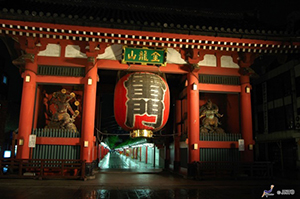
Sensoji Temple
Sensoji is the oldest and most impressive temple in Tokyo. The main hall was first built in 645 to house a tiny golden statue of Kannon, the goddess of mercy, that had been repeatedly hauled up in fishing nets despite being thrown back into the river. The statue was enshrined in the main hall where it ostensibly remains today -- a sight too holy to be seen. The temple was destroyed in the air raids of March 10, 1945, and the present building is a 1958 reconstruction. The temple precincts bustle with people praying, buying fortunes, shopping or sightseeing. Many come for the curative powers of smoke billowing from the bronze urn burning incense in front of the main hall. People rub smoke on joints in the hope of easing aches and pains.
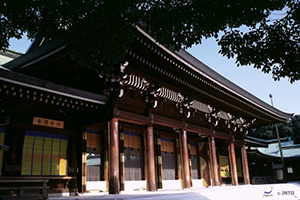
Meiji Jingu Shrine
Meiji Jingu is a Shinto shrine dedicated to Emperor Meiji and his wife, Emperor Shoken, the great-grandparents of the present emperor. The Meiji Emperor passed away in 1912 and the Empress Shoken, in 1914. The shrine, built in 1920, comprises three areas: the Naien, Inner Precincts, centered on the shrine buildings; the Gaien, or Outer Precincts, which include sports facilities and the Meiji Memorial Picture Gallery; and the Meiji Memorial Hall. The shrine spreads over 700,000 square meters covered by a forest of 120,000 trees of 365 species donated by people from all over Japan. Sumo wrestlers, upon rising to the rank of Grand Champion, give a demonstration bout at Meiji Jingu. For many Japanese the shrine is both a spiritual home and an oasis in Tokyo.
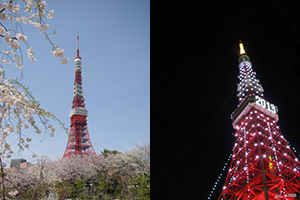
Tokyo Tower
Tokyo Tower, at a height of 313 meters, is the world's tallest self-supporting iron structure, edging out the Eiffel Tower by 13 meters. Its uppermost observation deck offers a spectacular view of Ginza, Tokyo Bay, Yokohama, and Mt. Fuji. It was completed in 1958 as a broadcast tower. Today it is a relay tower for five FM radio stations and nine TV stations. Among the tower's many attractions are an aquarium on the first floor and the Wax Works Museum and Mysterious Walking Zone of Hologram Technology on the third floor. Beautifully illuminated, the tower is a familiar landmark day and night.
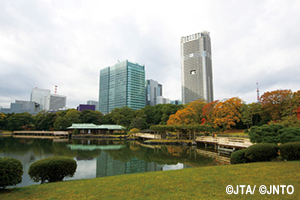
Hamarikyu Garden
The only surviving seaside garden of Japan's Edo Period, Hamarikyu Garden was constructed as a residence for a Japanese feudal lord in the 17th century and later was an official duck hunting grounds for the Tokugawa Shogunate before passing into the hands of the Imperial family during the Meiji Period. Ponds in the garden are fed by seawater and scenery will delicately change with the ebb and flow of the tide. Two duck hunting fields remain and the 300-year-old pine tree by the garden's entrance is the largest such tree in Tokyo. The garden is rich in flowers and sports a tea house on a small island within a pond. Hamarikyu Garden can be reached by various train lines, but ferries on the Sumida River also dock nearby.
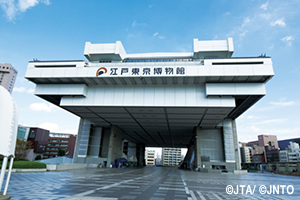
Edo-Tokyo Museum
The Edo-Tokyo Museum shows how the 15th-century village of Edo grew to be Tokyo, one of the largest cities in the world. The museum, established in 1993, recounts this story of remarkable growth through life-size replicas and detailed scale models. There is a life-size reconstruction of the Kabuki Theater, and reconstructions of Edo Castle and Nihonbashi Bridge. The museum accommodates international visitors with English explanations of exhibits, headphone sets, and volunteer English-speaking guides. The museum's futuristic building was designed after an elevated-floor type warehouse. It rises 62.2 meters, which was the height of the tallest tower of Edo Castle. With a total area of about 30,000 square meters, it is 2.4 times larger than the playing field of Tokyo Dome.

Akihabara
The Akihabara Electric Town is the world's preeminent playground for electronics and personal computer buffs and where, it is said, any electronic device ever made is available. Hardware, software, parts, second-hand goods, imports-all can be found in this digital wonderland. Electronic products can be purchased at reasonable prices, and if shoppers think prices are not reasonable, they can haggle. Many shops have a duty-free service corner for foreign visitors.
Kyoto
For more than 10 centuries, from 794 to 1868, Kyoto was the capital of Japan and the center of its civilization. Brimming with historical and religious traditions and being the birthplace of the country's traditional arts and crafts that have won the admiration of the world, Kyoto occupies a unique position amount the great cities of the world. Nestled picturesquely among the surrounding mountains, it still retains an old-world atmosphere. In spite of signs of materialistic progress, this ancient Buddhist center seems to be a place ,apart from the busy world, where the spirit of old Japan still prevails.
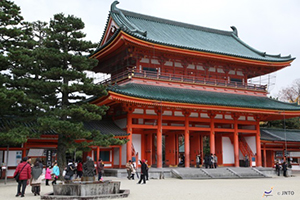
Heian Shrine
Heian Shrine is a famous structure dedicated to Emperor Kammu, the founder of Kyoto, and the Emperor Komei, the last emperor to reign at Kyoto. It was built in 1895 to commemorate the 1,100th anniversary of the founding of Kyoto. Its buildings, with the exception of the ferroconcrete torii gate, are miniature replicas of the first Imperial Palace built in Kyoto, in 794. The garden behind the shrine is well known for its water lilies, irises, azaleas, maples, and drooping cherry trees.
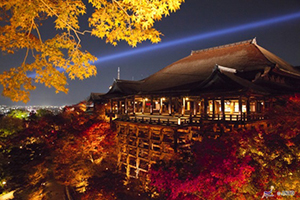
Kiyomizu Temple
Kiyomizu Temple is noted for its clifftop Main Hall with a broad wooden veranda affording a panoramic view of Kyoto and environs. The veranda is supported on a towering scaffold of wood. Situated on a wooded hillside, the veranda seems to hang in midair. The depth of the valley below is such that the Japanese expression "To jump from the veranda of Kiyomizu Temple" means to do something daring. The veranda was built on the temple's south side so that it would face the sacred Otowa Falls. The present temple structures were built in 1633 at the behest of Iemitsu, the third of the Tokugawa shoguns. The Main Hall has been designated a National Treasure.
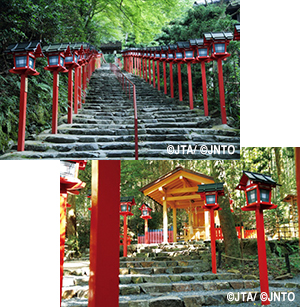
Kifune-Jinja Shrine
Kifune-jinja Shrine is an ancient shrine located in a village in the mountainous area north of Kyoto and is actually a complex of three shrines located in different positions up a hillside. The best-known feature on the grounds is the well-worn stone staircase lined by distinctive red wooden lanterns which evoke the feeling of an earlier time. Each of the shrines has its own appeal, the middle shrine being notable for its location in a grove of ancient, towering cedar trees, while the upper shrine is the oldest and original site of the Kibune-jinja Shrine.

Gion
Gion Corner is a small theater whose program serves as an excellent introduction to a range of traditional Japanese arts. These include the tea ceremony, flower arrangement, bunraku puppet plays, Kyomai (Kyoto-style dance) koto music, gagaku (court music) and kyogen (classic farce). The theater is on the first floor of Yasaka Kaikan Hall in Gion, a traditional entertainment district on the east bank of the Kamo River.












